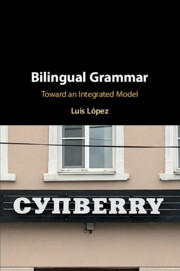Book contents
- Bilingual Grammar
- Bilingual Grammar
- Copyright page
- Contents
- Figures
- Acknowledgments
- 1 Introduction: Motivating a Unified Linguistic System
- 2 Remarks on Separationist Architectures
- 3 Phases, Distributed Morphology, and Some Contributions from Code-Switching
- 4 1Lex in MDM
- 5 Building the Case for 1Lex: Gender in Code-Switching
- 6 1PF in MDM
- 7 Lexical Questions: What Do You Learn When You Learn a Word?
- 8 Psycho-Syntactic Questions: Acquisition, Priming and Co-activation, and a Note on Processing Cost
- 9 Convergent and Divergent Paths
- 10 General Conclusions
- Book part
- Notes
- References
- Index
3 - Phases, Distributed Morphology, and Some Contributions from Code-Switching
Published online by Cambridge University Press: 02 May 2020
- Bilingual Grammar
- Bilingual Grammar
- Copyright page
- Contents
- Figures
- Acknowledgments
- 1 Introduction: Motivating a Unified Linguistic System
- 2 Remarks on Separationist Architectures
- 3 Phases, Distributed Morphology, and Some Contributions from Code-Switching
- 4 1Lex in MDM
- 5 Building the Case for 1Lex: Gender in Code-Switching
- 6 1PF in MDM
- 7 Lexical Questions: What Do You Learn When You Learn a Word?
- 8 Psycho-Syntactic Questions: Acquisition, Priming and Co-activation, and a Note on Processing Cost
- 9 Convergent and Divergent Paths
- 10 General Conclusions
- Book part
- Notes
- References
- Index
Summary
This chapter introduces the theoretical assumptions that ground the analyses in later chapters. I refer to this model as MDM: Minimalist Distributed Morhpology. It presents a minimalist syntax with emphasis on phases as cycles of syntactic derivation. Roots and categories are separated as distinct syntactic nodes and roots are reanalyzed as indices that link an Encyclopedia item with an exponent. Morpholoy is realizational, with an important role for impoverishment rules and vocabuary insertion rules. Code switching data is used to present these assumptions. The third module of the model is the Encyclopedia, where minimal syntactic structures find conceptual meaning.
Keywords
- Type
- Chapter
- Information
- Bilingual GrammarToward an Integrated Model, pp. 22 - 45Publisher: Cambridge University PressPrint publication year: 2020

